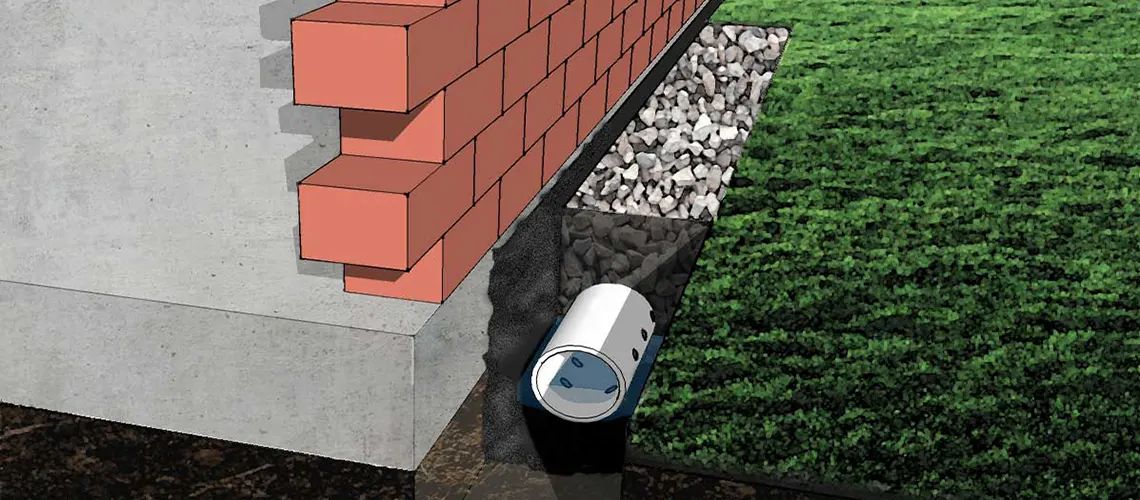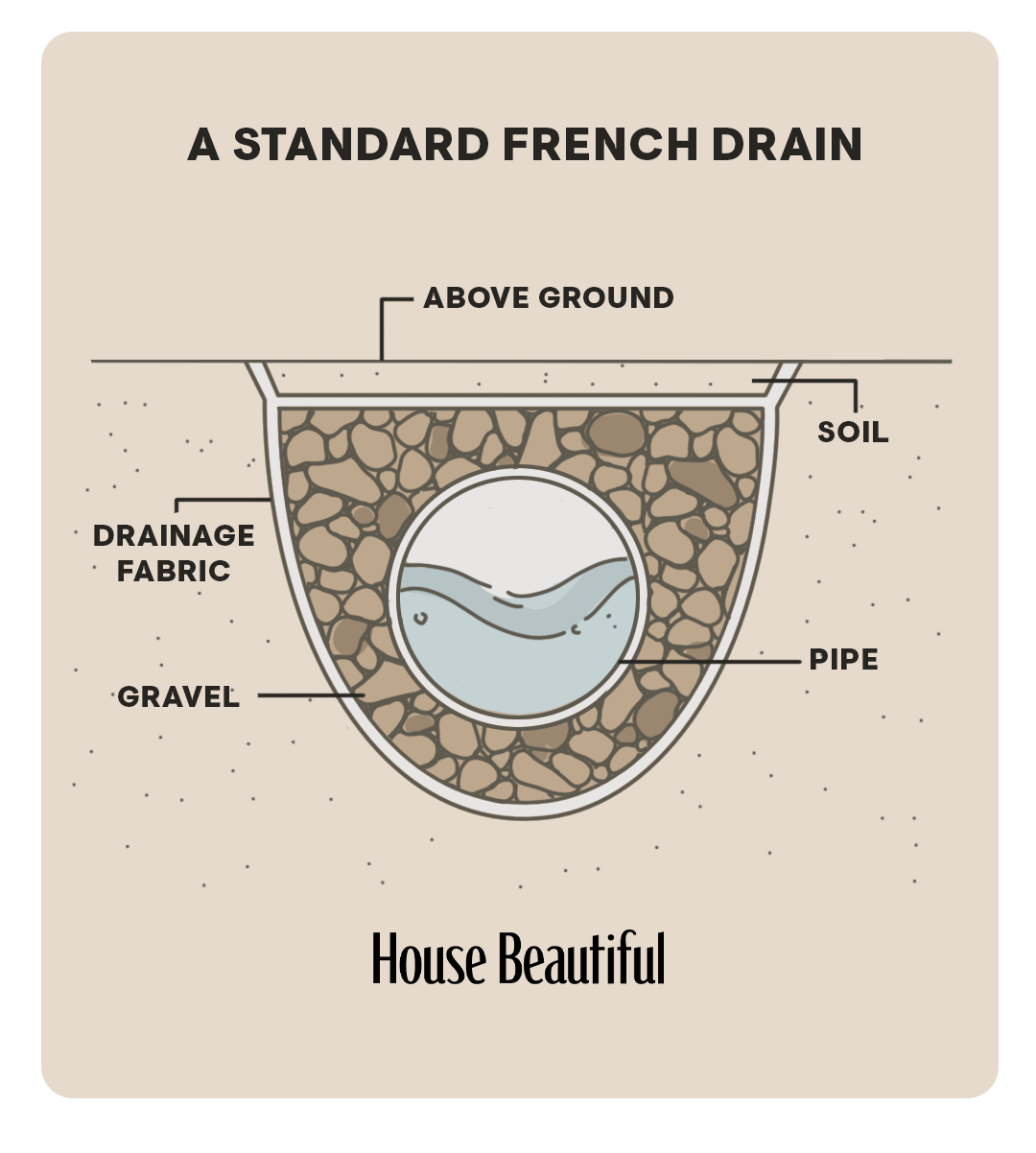Complete Guide About the Portland French Drain Process
Complete Guide About the Portland French Drain Process
Blog Article
The Vital Guide to Maintaining Your French Drainpipe for Resilient Efficiency
Preserving your French drain is key to its efficiency and your home's security. Regular checks can conserve you from pricey fixings and water damages. You'll wish to know what signs to seek and just how typically to examine your system. Plus, recognizing the cleansing process can make a significant distinction. Allow's explore the essential actions for ensuring your drain operates well for many years to come.
Comprehending the Function of a French Drainpipe
A French drain is an essential part in handling water around your home. It directs excess water far from your foundation, preventing flooding and damages. When heavy rainfall falls, the drainpipe collects water via a perforated pipe hidden in gravel. This system permits water to stream openly, reducing pressure on your basement walls and lessening the threat of leaks.You may ask yourself exactly how it operates in method. As water fills the soil, gravity draws it toward the drainpipe. The perforated pipe catches this water, transferring it to a marked drain location or storm drain. This procedure keeps your backyard dry and shields your home's structural integrity.Understanding exactly how a French drainpipe functions is crucial to appreciating its importance. By properly carrying water away, it aids maintain a dry and secure living setting. Maintaining your French drain in top problem warranties you avoid costly repair services down the line.
Regular Inspections: What to Search for
When you're evaluating your French drain, start by looking for any type of obstructions that could be obstructing water flow. Take note of signs of surface area disintegration around the drain, as this can indicate potential issues. Normal evaluations will assist keep your drain system working properly.
Obstructed Drain Evaluation
Exactly how can you tell if your French drain is blocked? First, look for water merging in your backyard, specifically after hefty rainfall. That's a red flag if you notice areas where water accumulates rather of draining pipes. You need to additionally inspect the drain outlet; if water isn't spurting as it should, there's likely a blockage. Pay attention for uncommon gurgling noises, which can indicate trapped air. Additionally, examine the drain's surface area for any kind of plants growth, as origins can penetrate and obstruct the system. If you scent mildewy odors, it might aim to stationary water caused by a clog. Consistently evaluating these signs can help you keep your French drainpipe effectively and prevent expensive repairs.
Surface Area Disintegration Check

Cleansing Your French Drainpipe: Step-by-Step Guide
Cleaning your French drain is vital for maintaining it working properly. You'll require some certain tools and a clear process to ensure whatever runs smoothly. Let's go through the actions and ideas for keeping your drain successfully.
Tools You'll Require
To take on the job of cleansing your French drain effectively, you'll intend to gather a couple of crucial devices. Order a strong set of handwear covers to shield your hands from particles and sharp things. A tiny shovel or trowel will help you remove dirt or blockages around the drainpipe. For cleaning out the inside, a plumbing professional's serpent or a high-pressure water nozzle can be incredibly useful. You'll also require a pail for gathering any debris you take out. Having a garden hose pipe on hand will make it easier to wash out the drainpipe and ensure it's flowing efficiently. With these devices all set, you'll be set for a complete cleaning session!
Cleaning Refine Steps
Start by assessing the area around your French drainpipe for any type of visible particles or obstructions. Eliminate leaves, branches, or dust that might block water circulation. Next, examine the inlet and outlet areas; clear any blockages to ensure appropriate drainage. Make use of a garden tube to flush the drain, routing water into the inlet. This aids dislodge any kind of collected sludge or sediment. If you see consistent blockages, take into consideration utilizing a plumbing's serpent to damage them up. After cleansing, inspect the crushed rock around the drainpipe; replenish it if it's washed away. Finally, confirm the drainpipe covers are intact and safely in area to stop debris from entering. Routine cleansing keeps your French drain working properly.
Upkeep Frequency Tips
While routine maintenance is important for your French drainpipe's long life, knowing just how typically to keep it can make all the distinction. Ideally, you ought to check your French drainpipe at the very least two times a year, preferably in springtime and fall. After heavy rainfall or snowmelt, look for clogs or particles. If you notice any standing water, it's time to clean your drain.In locations with hefty vegetation, even more constant upkeep-- about every three months-- may be required. Furthermore, think about cleansing your French drainpipe after significant tornados or if you observe water merging in your lawn. By remaining positive, you'll assure your French drainpipe features successfully and shields your residential property from water damages. Routine checks will save you money and time over time.
Determining Typical Issues and Their Solutions
It's essential to recognize typical problems with your French drain and carry out efficient services when you discover water pooling in your backyard or damp places in your basement. One frequent trouble is obstructing, commonly triggered by debris like leaves or debris. To fix this, you can use a pipes serpent or a high-pressure water jet to clear blockages.Another issue might be inappropriate slope. Water won't flow away from your home if your drainpipe isn't sloped properly. You can adjust the incline by excavating and repositioning the drainpipe pipe.Lastly, check for damages or fractures in the drain itself. If you find any kind of, changing the damaged areas is vital for peak efficiency. By attending to view it now these problems without delay, you'll aid assure that your French drain remains to work effectively, safeguarding your residential or commercial property from water damage and preserving a completely dry, risk-free atmosphere.
Seasonal Maintenance Tips for Your French Drainpipe
Dealing with common issues with your French drain is just the initial step in ensuring its long-lasting effectiveness. Seasonal upkeep is important for peak performance. In the spring, clear away leaves and particles that might have built up throughout winter. Look for any kind of blockages in the electrical outlet or catch container, as water requires a clear path to move freely.During summer, examine your drainpipe for any indications of moving or resolving soil. Make specific it's still level and functioning appropriately. As autumn strategies, clear out any kind of dropped delegates protect against obstructions before winter season arrives.In winter months, look for freezing temperatures. If you stay in a cool environment, ensure your drain isn't in jeopardy of freezing. Insulating revealed pipelines can help. Regular checks and prompt upkeep can avoid pricey repairs and keep your French drain working effectively year-round. Remain positive and enjoy assurance recognizing your drainage system is in good condition!
When to Call in a Professional
When to call in an expert can save you time and protect against further damages to your French drainpipe, recognizing. It's a clear indicator that your drainpipe may be obstructed or harmed if you discover consistent standing water in your yard. Do not ignore strange smells, as they can suggest sewer backup or decay, which requires prompt attention.If you locate that your drainpipe isn't working appropriately after attempts to clean or preserve it, it's time to connect for specialist assistance. In addition, if you're not sure about the underlying concerns or lack the essential devices, employing a professional can offer tranquility of mind.Finally, if your French drain is old or has actually experienced significant damage, professional analysis can identify whether fixings or complete substitute is required. Trust fund the professionals to assure your water drainage system works successfully for many years to find.
Tips for Preventing Future Water Drainage Issues
To keep your French drainpipe working successfully, on a regular basis inspecting and preserving it can make all the difference. Begin by getting rid of particles, leaves, and dirt from the surface area and drainpipe openings. This prevents obstructions that see this here can cause water backup. Check the gravel around the drain; if it's compressed or deteriorated, consider adding fresh gravel to maintain ideal flow.Next, divert water away from your drainpipe by making certain gutters and downspouts are clear and guiding water a minimum of 3 feet away from your structure. Regularly examine for any type of signs of damage or drooping. If you observe concerns, resolve them immediately.Finally, take into consideration installing a filter or a catch basin to trap larger debris before it enters the drain. By staying proactive with these tips, you'll reduce the risk of future drainage problems and keep your French drain in top form.
Often Asked Inquiries
Just how Lengthy Does a French Drainpipe Commonly Last?
A French drainpipe generally lasts around 30 to 40 years, depending on the products made use of and upkeep (Portland French Drain). If you stay up to date with regular checks, you can extend its lifespan also additionally
Can I Set Up a French Drain Myself?
Yes, you can install a French drainpipe on your own if you've obtained the right tools and expertise. Simply ensure to prepare thoroughly, comply with local laws, and assurance correct drain to prevent future issues.
What Materials Are Utilized in a French Drainpipe?
You'll need perforated pipeline, crushed rock, landscape material, and a solid water drainage pipeline for your French drain. These materials help reroute water effectively, protecting against flooding and maintaining your property risk-free and dry from water damages.

Is an Authorization Required to Set Up a French Drain?
You'll likely need a permit to install a French drainpipe, relying on neighborhood laws. Talk to your town to guarantee you abide by any essential guidelines and avoid potential concerns throughout setup.
What Are the Expenses Related To French Drainpipe Upkeep?
Preserving a French drain typically costs in between $100 and $500 yearly. You'll need to take right into account costs for cleansing, fixings, and examinations. Regular upkeep helps avoid bigger costs and assurances your system functions effectively for many years - Portland French Drain. When you're examining your French drainpipe, begin by checking for any kind of clogs that could be obstructing water circulation. By staying aggressive, you'll guarantee your French important source drainpipe functions successfully and protects your home from water damage. When you observe water merging in your yard or damp areas in your cellar, it's important to recognize common concerns with your French drain and apply efficient remedies. You can adjust the incline by excavating and repositioning the drainpipe pipe.Lastly, check for damage or fractures in the drainpipe itself. Check the gravel around the drainpipe; if it's compacted or worn down, take into consideration adding fresh gravel to keep perfect flow.Next, draw away water away from your drainpipe by guaranteeing seamless gutters and downspouts are clear and directing water at the very least 3 feet away from your foundation
Report this page